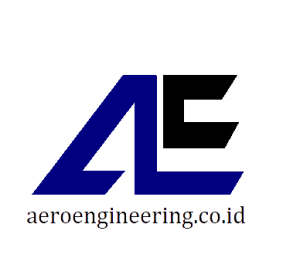In principle, an airplane can fly because its wings generate lift force. The principle of the formation of lift can occur because of the “suction” of air upward due to the shape of the airfoil that is designed in such a way. The formation of lift can also be caused by the higher angle of attack resulting in a greater upward reaction, but also followed by an increase in drag, which is termed induced drag.
To determine the size of the wing, the first thing we should understand is the relationship between the surface area of the wing and the lift itself, which is formulated by the equation:
L = 0.5 ρ CL V2 A
Where,
L = Lift force (N)
ρ = Air density (kg/m3)
CL = Lift Coefficient
v = Flight velocity (m/s2)
A = Wing’s area (m2)
From the above equation, it can be seen that the lift is directly proportional to the square of the flight speed. It means that when the aircraft moves twice as fast, the lift will increase fourfold. Then, the larger the cross-sectional area of the wing, the greater the lift will be, but the larger the area will certainly increase the weight of the aircraft, which makes the need for even greater lift. Then, the CL or coefficient of lift is influenced by several factors, namely the angle of attack, shape and Reynolds number which are basically determined when selecting the airfoil.
Theoretically (2D), the value of CL is only determined by the design of the airfoil and multiplied by its cross-sectional area (doesn’t depend on the shape of the cross-section itself). However, in fact the effect of the wing planform itself is very influential on the flow characteristics in 3D so that it affects the CLvalue, and must be taken into account in the calculation of the area. The parameters that play a role in the design of the airplane wing planform:

ASPECT RATIO
Aspect ratio is the ratio between span and wing chord, meaning that the longer the wing with the same width, the greater the aspect ratio. The aspect ratio selection is important for the mission carried out by the aircraft, a high aspect ratio is used for aircraft that are stable, relatively low speed and require long endurance, because the larger the aspect ratio, the smaller the induced drag. Then, a small aspect ratio is usually used for aircraft with extreme maneuvers, relatively high speed and does not require long endurance, in addition to the agility advantages of short wings (low aspect ratio), strength and structural rigidity are also the reasons why short wings are ideal for extreme maneuvers.
The induced drag referred to in the explanation above is due to the “leakage” effect of the flow from the bottom of the wing to the top of the wing that occurs at the tip of the wing. We know that to produce lift, the underside of the wing has a higher pressure than the top, and we also know that air flows from high pressure to low pressure. Leaking from the bottom to the top at the tip (tip) of this wing produces a swirling flow pattern, otherwise known as a tip vortex.

The equation used to calculate the aspect ratio is as follows:
AR = b/c
AR = b2/A
Where,
AR = Aspect Ratio
b = Wing span (m)
c = average chord (m)
A = Surface area (m2)
TAPER RATIO
The taper ratio is the ratio of the chord tip to the root chord, the thinner the wing shape, the lower the taper ratio. 1 taper ratio means the wings are rectangular. Mathematically defined as follows:
TR = Ctip/Croot
Where,
TR = Taper Ratio
Ctip= Tip Chord (m)
Croot = Root Chord (m)
The taper ratio has an effect on wing weight, the lower the taper ratio, the wing weight can be minimized, and the selection of the taper ratio determines the wing efficiency due to the effect of induced drag. The following is a graph of the relationship between the taper ratio and the induced drag factor:

The calculations above are very dependent on the 3D detail of the wing, so that in the end the final CLand CD values are calculated using experiments or methods that are currently quite widely used are Computational Fluid Dynamics (CFD) because of their relative flexibility, speed, and cost. lower than the wind tunnel experiment.
We also provide engineering consulting and project support for computational fluid dynamics. For more information, click here!
